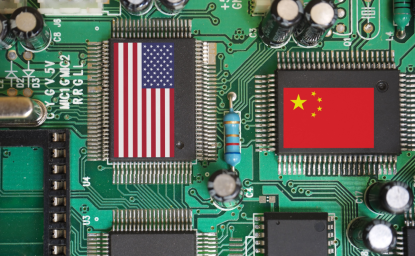The ship that crashed into and destroyed the Francis Scott Key Bridge is a reminder that supply chain disruptions can happen. When they do, it helps to have options.
Businesses and governments in the United States and Canada have learned the value of a backup option during past crises. Border disruptions on September 11, 2001, and in 2020 following the COVID19 pandemic required work arounds. Domestically, the collapse of an Interstate 5 bridge over the Skagit River in 2013 and the tanker truck fire on Interstate 95 in Philadelphia in 2023 made national headlines and forced logistics managers to reroute trucks quickly.
Disruptions to US critical infrastructure can affect North American trade.
The majority, as much as 75 percent, of trade in North America between the partners in the United States Mexico Canada Agreement (UMSCA) moves by truck, rail, pipeline, or power line; in other words, on land. That creates a vulnerability to disruptions to physical infrastructure that can negatively impact regional competitiveness.
After the North American Free Trade Agreement (NAFTA) took effect in 1994, American, Canadian, and Mexican firms reduced production costs through just-in-time logistics. Through careful planning, components are delivered “just-in-time to be used, eliminating warehouse inventories. The resulting savings helped firms to compete with companies in China that paid workers far less.
On September 11, 2001, some automotive assembly plants shut down when increased security at the border delayed the arrival of parts. Continuing border uncertainty led many companies to adopt a just-in-case model, re-establishing inventories of critical parts as a buffer. Other businesses established second production lines across the border so that customers would get deliveries on time even when there were border delays. For many of us who have become accustomed to just-in-time logistics, the return of inventories created concern about regional competitiveness.
The governments that increased border security responded to just-in-case logistics with significant investments in transportation infrastructure. Their first goal was to redesign border crossings to allow for new inspection technologies and faster clearance times. Later, governments invested in repairing and updating aging infrastructure and improvements to speed the flow of commercial traffic. New roads and bridges offered a backup plan for companies and were particularly beneficial to small and medium sized businesses that lacked the capacity to sustain buffer inventories.
The most important joint infrastructure investment made by the United States and Canada since 2001 is the Gordie Howe International Bridge, a high-capacity connection between Interstate 75 and Highway 401 across the Detroit River. The new bridge is downriver from the Ambassador Bridge which opened in 1929. The private owners of the Ambassador Bridge opposed adding the new crossing in court and in public relations and political campaigns, seeing it as a threat to their business (the operators charge a toll to access the Ambassador Bridge). The fights over the new bridge roiled politics in Michigan and complicated US-Canadian relations for years.
The rationale for the Gordie Howe International Bridge was never to put the Ambassador Bridge owners out of business. It was about adding capacity and redundancy, just in case.
Commercial traffic through Baltimore will be rerouted following the collapse of the Francis Scott Key Bridge. The bridge was part of the Interstate 695 beltway around Baltimore, a crucial bypass for trucks carrying hazardous materials on Interstates 95 and 895 that was prohibited in the tunnels that these routes use to pass under Baltimore Harbor. Those trucks can take the long way around the city by taking the western arm of the Baltimore Beltway, or their cargo could be switched to rail or another transportation mode. The extra time in transit will add to costs for firms temporarily and dent the competitiveness of the mid-Atlantic region, prompting Congress to quickly approve funding for a new bridge.
Yet in comparison to the recent disruptions to maritime shipping through the Panama Canal (due to low water levels) and the Red Sea (due to attacks by Houthis from Yemen), overland cargo supply chains in North America hold a distinct advantage: it is easier to reroute trucks quickly than ships. Railway cargo is less flexible due to fixed rail networks, but with time shipments can adjust.
The introduction of Artificial Intelligence (AI) and machine learning to supply chain management is already making overland cargo logistics more agile and resilient when disruptions occur. AI allows managers to recalculate routes and find alternative suppliers for critical components in seconds. Many North American supply chains will utilize AI to reduce or eliminate just-in-case buffering, moving to a just-a-second model that adapts to shocks and can squeeze cost savings from supply chains.
The next frontier in North American supply chains is in the way that energy and fuels are delivered. Today’s networks of pipelines and power lines are fragile and lack the redundancy of road and even rail networks. When a snowstorm or hurricane knocks out power lines, or an earthquake or leak damages a pipeline, there are few rerouting options.
AI systems require vast amounts of electricity to operate. Ironically, the AI applications that enable firms to manage cargo supply chains more efficiently will put pressure on already fragile energy supply chains. And when energy infrastructure fails, the disruption will spread quickly to production lines.
The responsibility for avoiding such North American supply chain shocks rests with public and private sector leaders who must plan today for infrastructure that will enable agile production and resilient supply chains tomorrow. Canada and Mexico each have work to do, but the United States is at the geographic heart of North America, and US infrastructure to connect commercial and residential consumers with goods and energy is essential not only to American competitiveness, but to the economic prospects of Canadians and Mexicans, too. Politicians seeking to “Make America Great Again” or to “Build Back Better” should heed the infrastructure lessons of a broken bridge in Baltimore.
Author


Canada Institute
The mission of the Wilson Center's Canada Institute is to raise the level of knowledge of Canada in the United States, particularly within the Washington, DC policy community. Research projects, initiatives, podcasts, and publications cover contemporary Canada, US-Canadian relations, North American political economy, and Canada's global role as it intersects with US national interests. Read more





